.
The Rendlesham UFO witness statements
.
On the next page are the original statements provided by five of the main participants on the first night of the Rendlesham Forest UFO sighting (1980 December 26). Three of these men went into the forest (Penniston, Burroughs, and Cabansag) while two others monitored their communications (Chandler and Buran). The statements allow us to reconstruct what the trio in the forest saw and did, and to trace their route. The statements tell a consistent story of the pursuit of an unknown light which turns out to be more distant than first thought, and is eventually identified as the Orford Ness lighthouse. There is no mention of an encounter with a landed craft, no loss of radio communication and no ‘missing time’, all of which have been added to the story more recently by Penniston and Burroughs.
Paragraph 1 of Col. Halt’s subsequent memo to the Ministry of Defence was based on these statements and his own interviews with the witnesses. Halt later presented the statements to Citizens Against UFO Secrecy (CAUS) from where they were obtained in 1997 by Scottish researcher James Easton, to whom I am grateful for providing these scans. Their authenticity has been confirmed by Col. Halt, who annotated each with some personal comments about the authors. I have removed those, but they can be seen on the versions printed in Georgina Bruni’s book You Can’t Tell the People.
One of the statements is by the officer in charge at Central Security Control (CSC) on the night in question, Lt Fred ‘Skip’ Buran, who helped gather the statements from the others. It is sometimes said that the statements were deliberately toned down or sanitized, but Buran told me by email on 2007 December 30: “I did not ask anyone to edit their statements in any way. Had anything occurred other than what appeared in the statements, those facts should have been included.”
These statements should be read in conjunction with the report of the local Suffolk police who were called to the scene of the incident on the first night and again the following morning.
A number of points are worth making:
1. The statements give the correct date for the sighting (December 26). This makes it even more surprising that Col Halt got the date wrong in his memo. Penniston’s statement is the exception, as it is undated (but see Point 5 below).
2. The only witness to claim he saw a mechanical object was Penniston. The others have only ever described seeing lights. During the incident, Penniston estimated that he got no closer than about 50 metres to the object and that every time he tried to approach it, it moved ahead of him. This was relayed at the time by radio to his supervisor, Master Sergeant Chandler, who confirms it in his own statement. There was no mention at the time of the much closer and extended encounter that Penniston has since claimed (see Point 5).
3. Col Ted Conrad, Halt’s superior officer, debriefed Penniston in the days after the event. Conrad told researcher David Clarke in 2010 June that Penniston confirmed that he did not get close enough to the object for a detailed look, confirming what Penniston said in his written statement. According to Conrad, Penniston said he followed the light through the trees to an open field whereupon it disappeared beyond a small rise in the direction of a farm house. That is consistent with the statements of Burroughs and Cabansag, although the detail about the farmhouse is not mentioned in Penniston’s own typewritten statement.
4. Burroughs and Cabansag confirm that they chased this unidentified light for about two miles before realizing what it was. Evidently they were not as familiar with the lighthouse as proponents of this case like to claim – see also Point 9 below. In an interview on The Paracast in 2009 Burroughs stated he had never been out in the woods before that night. Penniston and Cabansag were newly arrived on base and were no more familiar with the woods than he was (scroll to 08:40, 25:35 and 33:15 in the Paracast interview).
5. In more recent television interviews Penniston has exhibited a notebook in which he claims he made real-time notes and sketches of a landed craft for about 45 minutes (see picture below). However, there are serious problems with this claim. For one thing, the date in the notebook is December 27 and the starting time is noted as 12:20 (presumably meaning 00:20). This, as we know, does not accord with the established date and time. Burroughs, who was within a few yards of him throughout the incident and saw no craft, told me in an email on 2006 March 22: “Penniston was not keeping a notebook as it went down”. In a further email dated 2008 January 17 Burroughs emphasized: “Penniston did not have time to make any sketches in a note book while this was going on and did not walk around it for 45 min.” Penniston now claims the date and time refer to a stream of binary digits he received telepathically and wrote down while at home the following day, but unfortunately that is not what the notebook shows.
.

Jim Penniston’s notebook
Airman Jim Penniston showed this notebook on the Sci Fi channel documentary UFO Invasion at Rendlesham first broadcast in 2003.
The first page, shown here, is headed with the date “27 Dec 80”. Below is written “12:20. Response notes. A/C [i.e. aircraft] crash”. The rest is hidden behind his hand.
Penniston claims to have made these notes at the time of the incident. For a fuller discussion of this notebook, see here.
.
Above: The notebook that Jim Penniston claims he made on the first night of
the Rendlesham Forest event has the wrong date and time.
Potentially one of the most explosive documents in the Rendlesham Forest case – if not all of UFOlogy – is the notebook allegedly made by Sergeant Jim Penniston during the UFO encounter outside East Gate of RAF Woodbridge experienced by himself, John Burroughs and Ed Cabansag in December 1980. The notebook contains descriptions of a landed craft of unknown origin (see below) that Penniston claims to have examined for 45 minutes and even touched, along with sketches of hieroglyphic inscriptions he says were engraved on its side. None of the other witnesses that night claims to have seen any such craft, only lights. Hence this document deserves closer scrutiny than it has hitherto received. The results raise serious doubts about its authenticity.
Wrong date and time
Penniston first showed this notebook publicly on the Sci Fi channel documentary UFO Invasion at Rendlesham broadcast in 2003 December. (This is the same notebook which in 2010 December we were told also contained many pages of telepathically downloaded binary code, but more of that in the 30th anniversary update, below.) Immediately we can see a problem – the notebook contains the wrong date and time for the event.
The first page, shown above, is headed with the date “27 Dec 80”. Below is written “12:20. Response notes. A/C [i.e. aircraft] crash”. The rest is hidden behind his hand. Although the time may at first look like 12:50, inspection of the TV footage shows it is 12:20. At the bottom of the next page is another time; this looks to be either 12.31 or 12.51. These times should should really be expressed as “0020” etc. The 24-hour clock is standard in military, aviation and emergency services usage, and at the time of the Rendlesham incident Penniston came under all three headings, so why he used the civilian 12-hour clock is a puzzle.
Penniston claims to have made these notes and sketches at the time of the incident. When I asked him in 2010 April, via the Rendlesham Forest Incident online forum, to explain the inconsistency in date and time with the known date and time of the incident (i.e. 3 a.m. on December 26), he replied that the figures in his notebook “are the actual time and date of the event”. Unfortunately, we have independent evidence that they are not. This basic error in date and time is enough to raise serious doubts about whether the notes were made during the encounter as Penniston claims. Click here for a 45-second clip from the Sci Fi channel programme in which Penniston turns the first few pages of the notebook before stopping, apparently in emotional turmoil. Is Penniston acting for the camera?
Later on in the same programme, he reads through more of the notes, which end: “Liftoff 2.45. No sound. No exhaust. Takeoff unknown. Speed: impossible.” Some additional pages from the notebook were also shown in the History Channel’s documentary called Britain’s Roswell first broadcast in 2005 December, and a documentary called I Know What I Saw aired in 2009 December (for a 2-minute clip of Penniston’s description of his encounter from the latter programme see here). Unfortunately, none of the programme makers seems to have subjected this vital document to independent scrutiny.
When was the notebook first mentioned?
What other information can we find about the origin of Penniston’s supposed ‘real-time’ notes and sketches made in Rendlesham Forest? The first mention of them that I can find is in an interview with Penniston by Salley Rayl for Omni magazine – the date of the interview is not given but the website on which it appears is copyrighted 1996. Penniston made no mention of any notes or sketches in the extensive interviews he gave for a British TV programme called Strange But True? in July 1994.
In the Omni interview Penniston says that the object was sitting in a clearing when he approached it.
“I had my notebook and camera while I was out there, so I began taking notes. This is what I wrote: ‘Triangular in shape. The top portion is producing mainly white light, which encompasses most of the upper section of the craft. A small amount of white light peers out the bottom. At the left side center is a bluish light, and on the other side, red. The lights seem to be molded as part of the exterior of the structure, smooth, slowly fading into the rest of the outside of the structure, gradually molding into the fabric of the craft’.”
However, now that we have had a chance to see the notebook for ourselves on three separate TV documentaries there is no sign of this fluently written passage. Rather, the notes visible on the pages shown to camera are brief and disjointed. Was Penniston simply idealizing his description for Salley Rayl, or is there another explanation?
Perhaps the first person to see Penniston’s notebook after the alleged UFO encounter was a security guard at Bentwaters, Richard Bertolino. Bertolino recalls sitting next to Penniston on the pick-up bus after they both came off duty that morning, within hours of the event. In an interview with the Earthfiles podcast broadcast in 2009 September, Bertolino recounted that Penniston “pulls out the notebook and he diagrams what he saw out there. It was kind of diamond-shaped with tripod legs.” From this, it sounds as though Penniston sketched the object for Bertolino as they sat together. Bertolino does not mention seeing any existing notes or sketches of the craft in the notebook. And where is this diagram made for Bertolino in the notebook that Penniston now displays for the cameras?
Other inconsistencies
There are other troubling inconsistencies. In Penniston’s undated witness statement made shortly after the event he drew the craft as boxy in shape and apparently on legs. An inset detail of the craft is accompanied by a question mark, presumably indicating some uncertainty. One is left to wonder why he would query the drawing if he had examined the craft in close-up for 45 minutes. In another, more detailed sketch, made at some unknown time and dated “27 December”, Penniston depicts the craft as triangular, like the landing marks, and shows it from three directions: front, side and top. The impression is sometimes given that this sketch of a triangular craft was part of Penniston’s original witness statement, but it was not. Neither does it come from his notebook, because the paper is different. This sketch seems to have surfaced around 1997 at the same time as an interview he gave with Salley Rayl, and was published on the Microsoft Network's UFO forum.
Col Ted Conrad, the base commander and boss of Lt Col Halt, interviewed Penniston a day or so after the incident. As Col Conrad recalled in 2010 for researcher Dave Clarke, Penniston simply reported that he and Burroughs moved through the trees towards an unknown light which disappeared behind a low rise in the direction of a farmhouse. There was no mention of an encounter or a notebook. “Penniston said he didn't get close enough for a detailed look,” recalled Conrad.
Given the doubts and questions surrounding these notes and sketches, it would be unwise to rely on them as evidence for a landed craft in Rendlesham Forest.
30th anniversary update
On the 30th anniversary of the event in December 2010 Penniston added a new twist to this part of the story. He claimed that the day after the initial encounter with the landed craft, he wrote down in his notebook many pages of binary digits that he had received telepathically. At the same time, he changed his explanation for the date and time shown in the notebook: he now says it was when he wrote down the binary, not when he encountered the craft. Unfortunately, as we can see for ourselves, the date and time is at the start of the description of the craft, and not at the start of the section with the binary codes. Hence Penniston’s revised explanation for the wrong date and time is contradicted by the notebook itself.
In addition, he also changed his story about the location of the landing site. Instead of claiming to have encountered the craft on the western side of the forest, nearest to East Gate, he now says the encounter did indeed take place near the eastern edge of the forest but much further south than the site with the ‘landing marks’ investigated by Col Halt. Unfortunately, this is not supported by the sketch that was included with his witness statement.
Hence, as Penniston’s story has grown, it has become riddled with inconsistencies and contradictions that serve only to cast further doubt on the veracity of his extraordinary claims.
More about Penniston’s “craft of unknown origin”
* Penniston usually refers to what he allegedly encountered as “a craft of unknown origin” but has specifically and repeatedly denied that it was extraterrestrial. So where was it from? After undergoing regression hypnosis in September 1994 he seems to have become convinced that it was a craft from tens of thousands of years in the Earth’s future. According to what Penniston told the hypnotist, it contained our distant descendants returning to obtain genetic material to keep their ailing species alive: “They are time travellers. They are us,” he said.
It sounds like the plot of a B movie, and very possibly that’s where it came from. A TV movie called Official Denial was broadcast on the Sci Fi channel in November 1993 and was released on video in May 1994, both within a year prior to Penniston’s hypnosis. In it, an alien craft is shot down by the USAF and lands in a forest. It contains creatures that are here “To get genetic material to help them reproduce because their race is dying out.” And where are they from? “They’re not aliens. They’re us. From the future – our future.” The similarities with Penniston’s story including the statement “They are us” are striking. This would not be the first time that a UFO witness under hypnosis has told a story from false memory based on a TV show. (Thanks to Stephan Könen for the tip-off and Adrian Frearson for help with research.)
.
6. Penniston’s statement and accompanying sketch map (reproduced on the next page) clearly refer to the “traditional” landing site on the eastern side of the forest, where the supposed landing marks and tree damage were found and which the local police were called to see the following morning. However, on the Sci Fi channel programme mentioned above Penniston claimed there was a second landing site on the near side of the forest, only a few hundred yards from East Gate, where he approached and examined the craft. This site is not attested to by other witnesses and is not referred to in his original statement or sketch map. On the 30th anniversary of the event, in December 2010, Penniston dropped this alternative landing site in favour of one in the southern part of the farmer’s field. However, this does not accord with their story of taking a direct route towards the light, nor of seeing a light in line with the farmhouse that turned out to be the Orford Ness lighthouse.
7. In TV interviews, Burroughs and Penniston have said that the supposed object took off over the trees, but there is no hint of that in these statements, which simply refer to the light(s) moving through the trees and disappearing without explanation. Master Sergeant Chandler, who was at the edge of the forest monitoring events and would have been well placed to see anything taking off, says in his statement that he saw nothing at any time. In the more recent Paracast interview referred to above, Burroughs said it went up and back towards the coast (scroll to 21:35 into the interview). When another colleague, Chris Armold, visited the site with Burroughs about an hour later the lights were still visible in the distance (see Point 9).
8. According to Burroughs, the initial sighting of an object apparently coming down in the forest around 3 a.m. was made by Bud Steffens, with whom he was riding on patrol. Steffens did not go out into the forest and was not asked for a statement. Steffens has never spoken publicly about the event.
9. In addition to those who provided written witness statements, there was another significant participant in the events of Night One: Chris Armold, the USAF law enforcement officer who placed the call to the British police and later went out to see for himself what was happening. James Easton tracked him down in 1997. This is part of what Armold had to tell him:
“I met Burroughs at the East Gate of WB [Woodbridge]. We left our guns with the guy riding with Burroughs and drove to the end of the long access road. We left our vehicle and walked out there.
“There was absolutely nothing in the woods. We could see lights in the distance and it appeared unusual as it was a sweeping light, (we did not know about the lighthouse on the coast at the time). We also saw some strange colored lights in the distance but were unable to determine what they were.
“Contrary to what some people assert, at the time almost none of us knew there was a lighthouse at Orford Ness. Remember, the vast majority of folks involved were young people, 19, 20, 25 years old. Consequently it wasn't something most of the troops were cognizant of. That's one reason the lights appeared interesting or out of the ordinary to some people.”
Easton published the interview in full on his website (note: the original site has long disappeared; this link is to an archive server which is very slow in responding.) The first part of the linked page details the background and reaction to the initial release of the witness statements. Scroll down about two-thirds of the way to reach the section on Armold.
10. In 1998, Easton heard from Bernard Donahue, who at the time of the incident was Area Defense Counsel at Bentwaters with the rank of Captain, the lawyer charged with defending personnel charged with offences. He said: “Most of us on base were embarrassed by this ‘incident’. We didn’t believe the UFO hype for one minute. The next day, I personally read the Security Police Blotter [the Bentwaters police log] describing the incident in detail. It seemed to document hysteria rather than hard facts.”
11. In the days following the events of December 26 and 28, Halt and Penniston were debriefed separately by Col Ted Conrad, Halt’s boss. These were the only two witnesses Conrad talked to. It is sometimes claimed in UFO circles that the witnesses were subjected to interrogation by the Air Force Office of Special Investigations (AFOSI), including injections by the so-called “truth drug” sodium pentothal. However, in 2010 January Col Conrad told researcher David Clarke that no investigations beyond his own had been conducted. Conrad stated: “There were no conspiracies, no secret operation, no missile accident, and no harsh interrogations by OSI. I was in a position to know about the OSI. They had their own chain of command, but in practice the OSI commander kept me informed of any ongoing investigations they had.”
.
Here are the original statements provided by five of the participants on the first night of the Rendlesham Forest UFO sighting (1980 December 26). The statements are presented in alphabetical order of the witness’s name.
.
1. Statement by Lieutenant Fred A. Buran, 81st Security Police Squadron.
Typed on USAF form 1169 "Statement of Witness", dated 2 January 1981:
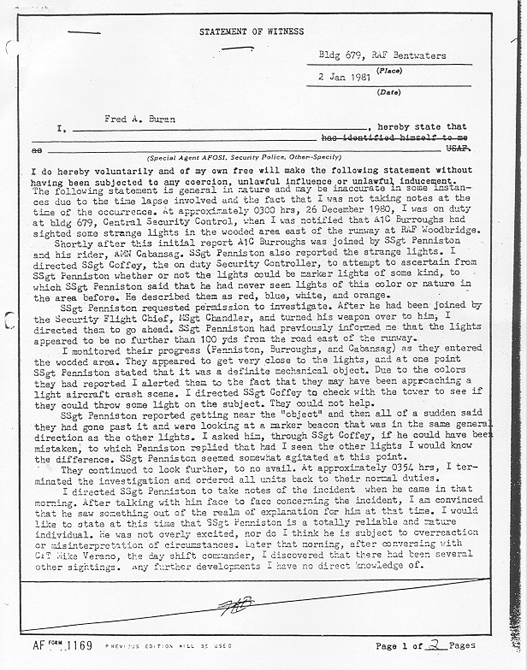
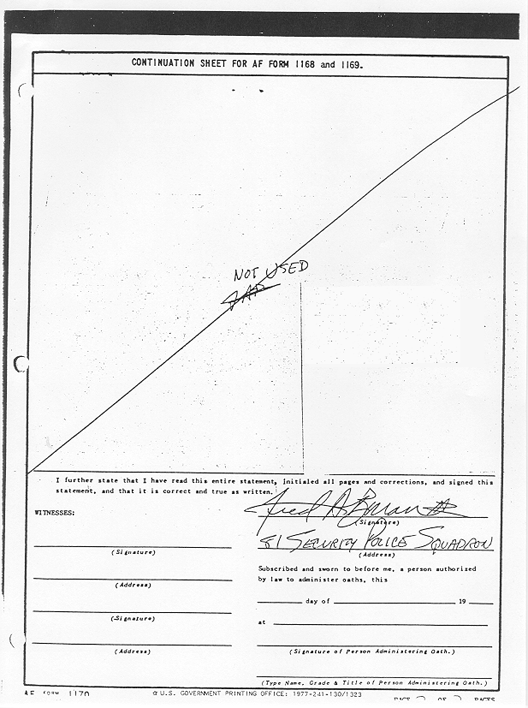
Note: Lt Buran was the most senior officer involved on the night in question. He was the shift commander in Central Security Control (CSC) at Bentwaters. Thinking there had been an aircraft crash, he allowed members of the security police to investigate, and ordered them back when nothing was found. Buran went on leave after the event until the New Year, but on his return he wrote out the statement above. Buran elaborated on his role and knowledge of the incident in a series of public postings in 2010 November on the Justice for the Bentwaters 81st Facebook page run by Jim Penniston and John Burroughs. He concluded: “I think Cabansag's statement gives the best explanation of the lights” [i.e. it was the lighthouse].
.
2. Statement and drawing by Airman First Class John Burroughs, 81st Security Police Squadron.
Hand-written and undated:
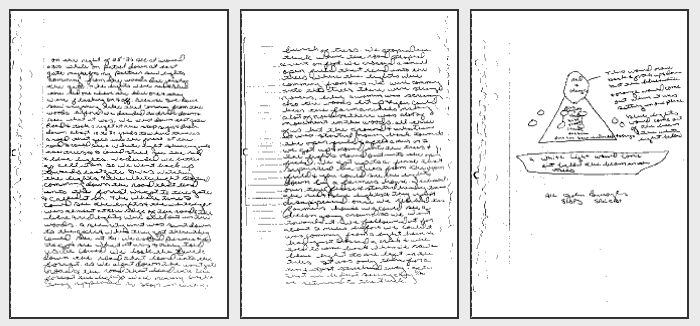
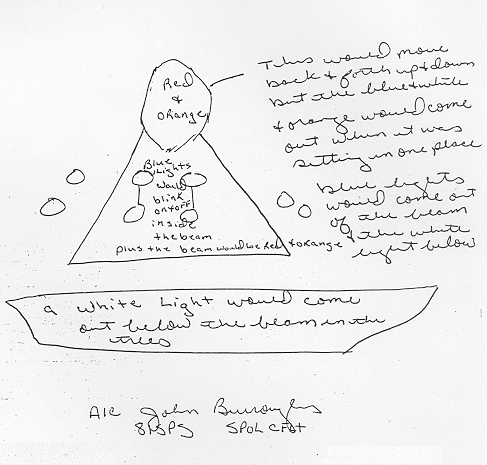
Note: The “strange noises, like a woman screaming” reported on page 2 of the above deposition were most likely caused by muntjac deer, which scream in this way when alarmed. The other noises and movement in the woods were probably also caused by these same deer. Col Halt heard similar noises during his own investigation two nights later. It’s worth noting that in an interview on The Paracast in 2009 Burroughs stated he had never been out in the woods before that night. Penniston and Cabansag were newly arrived on base and were no more familiar with the woods than he was (scroll to 08:40, 25:35 and 33:15 in the interview). Burroughs added a diagram of the lights he saw, which bears no obvious resemblance to the small, boxy object drawn by Penniston in his statement (below).
.
3. Statement by Airman Edward N. Cabansag, 81st Security Police Squadron.
Typed and undated:
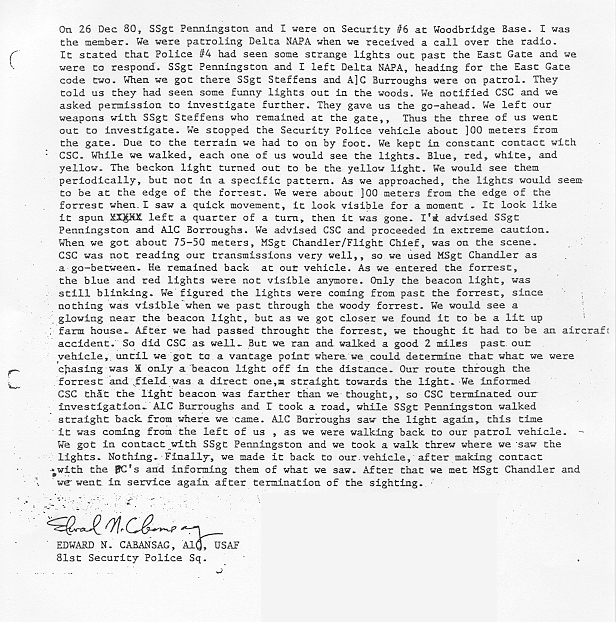
Note: Cabansag agrees with Burroughs that they walked eastwards for two miles from their vehicle towards a “beacon” light; however, this estimate may be an exaggeration, as the difficult terrain would have made the distance feel greater than it was. Burroughs finally identified the beacon as a lighthouse.
.
4. Statement by Master-Sergeant J. D. Chandler, 81st Security Police Squadron.
Typed on USAF form 1169 "Statement of Witness", dated 2 January 1981:
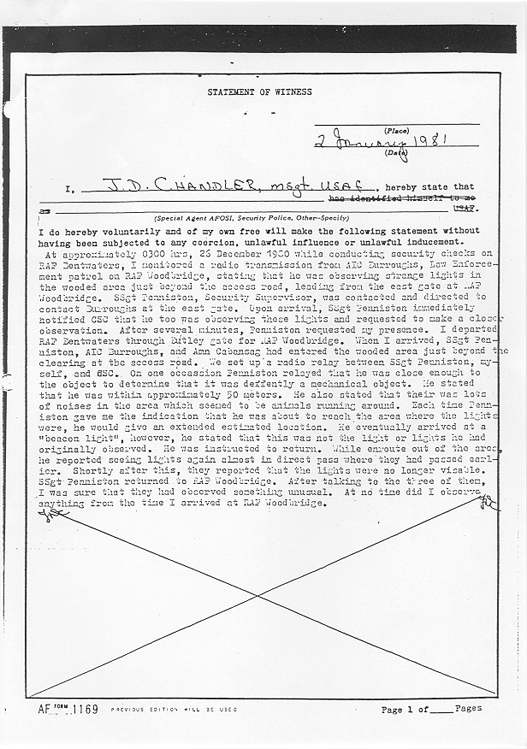
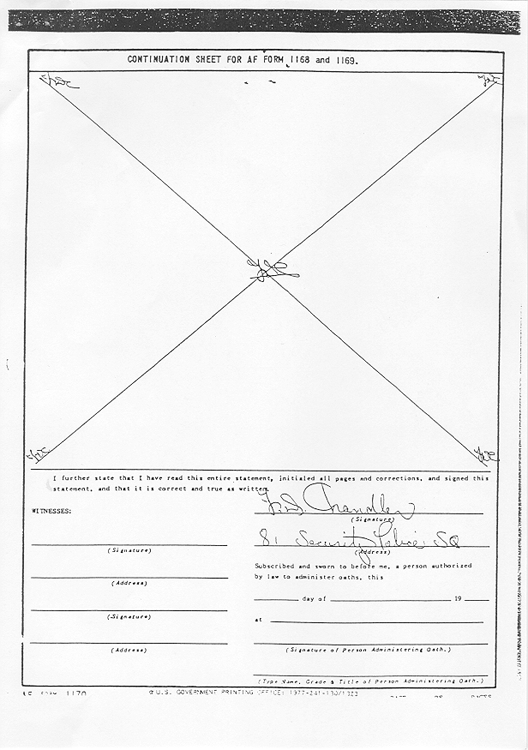
Note: Master Sergeant Chandler was the most senior officer in the forest on the first night. He was in radio contact with Penniston throughout the incident, relaying progress back to Sergeant Coffey at Central Security Control, Bentwaters. Chandler reports no loss of communication or “missing time”, as some versions have subsequently suggested. However he does mention Penniston’s identification of a “beacon light” (i.e. the lighthouse), a significant detail that is missing from Penniston’s own written statement.
.
5. Statement and two drawings by Staff-Sergeant Jim Penniston, 81st Security Police Squadron.
Typed and undated:
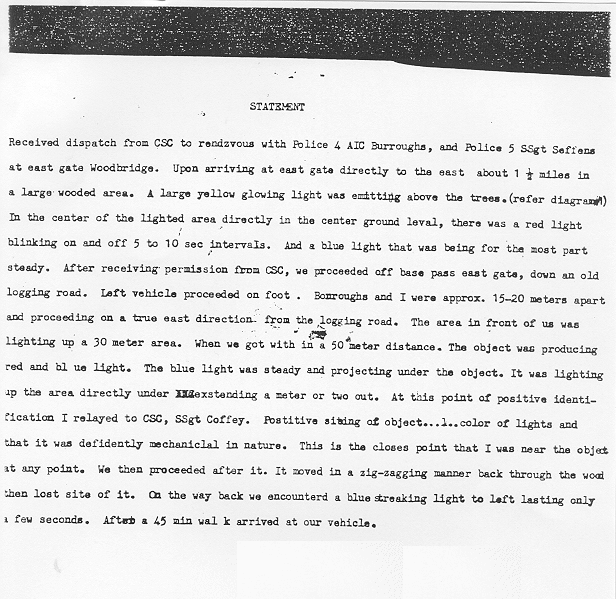
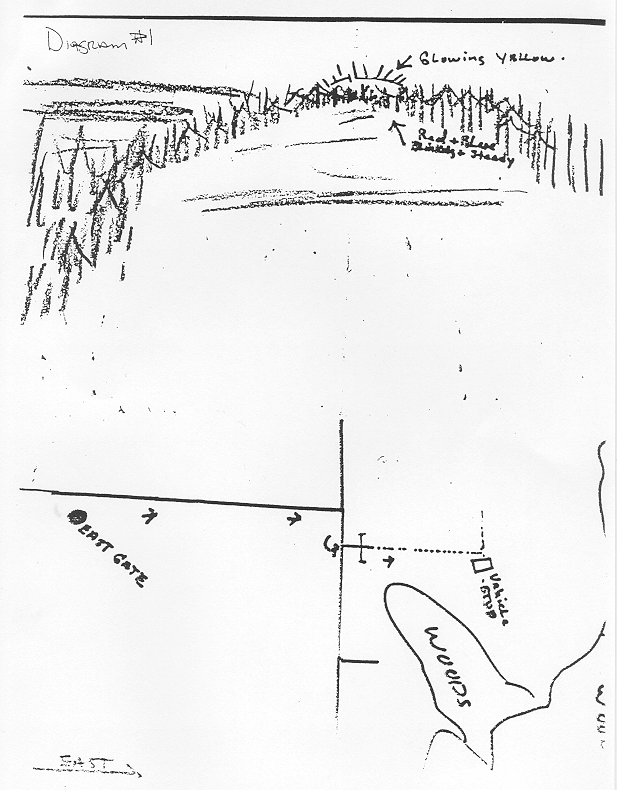
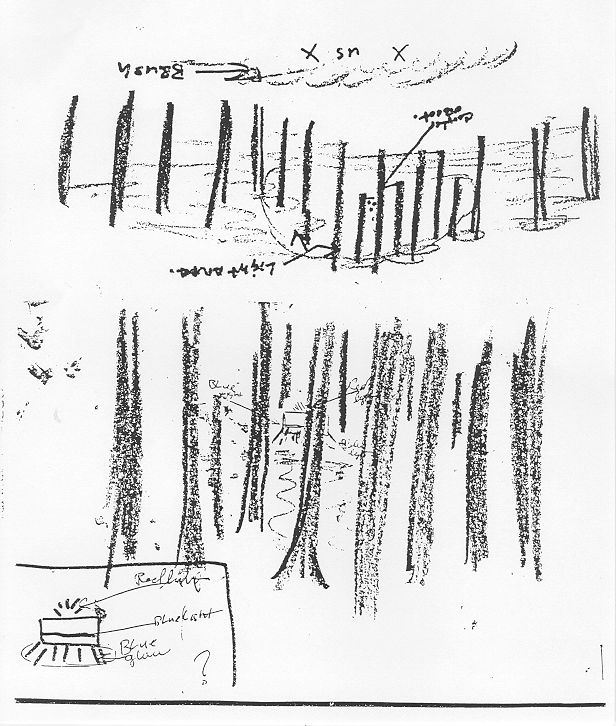
Note: Unlike the statements by Burroughs and Cabansag above, Penniston’s statement did not mention the lighthouse and it was neither signed nor dated. Had Penniston already realized their mistake and was he already working on deniability?
Penniston’s route from East Gate to the point where he and Burroughs left their vehicle and proceeded on foot is shown in his sketch above centre. I have plotted this route on an aerial photograph of the region, along with the position of the supposed landing site investigated by Col Halt two nights later.
In the right-hand drawing, the boxy object on stilts between trees is quite different from the larger, triangular craft Penniston showed on a separate drawing. (I have not been able to find out when this other drawing was made, but it bears the same wrong date as Penniston’s notebook, i.e. December 27.) The inset detail at bottom left of the page above is accompanied by a question mark, perhaps betraying some uncertainty.
Content last modified 2012 December
.
Transcript of Col. Halt’s tape
Transcribed by Ian Ridpath
.
This is a transcript of the cassette tape recording made by Lt. Col. Charles Halt on the night of the second sighting of the Rendlesham Forest UFO, i.e. the early hours of 1980 December 28. (The first sighting had been in the early hours of December 26, in which Halt was not involved.) Halt made the recording on a hand-held Lanier micro-cassette recorder which he carried for note-taking. There are many gaps and jumps in the recording as he switched the machine on and off.
As Halt explained in an episode of The UFO Hunters first broadcast in 2008: “The tapes are 20 minutes in duration, so there’s no way I could have kept the tape running the whole time. I must have stopped that tape a hundred times. I was going click-click-click-click the whole time we were out there because I didn’t want to run out of tape.”
Although the tape itself lasts just over 18 minutes it covers activities spanning a period of hours. Those familiar with the case will recognize certain differences between the descriptions on the tape and Col. Halt’s more recent recollections from memory.
To set the scene: On the night of Saturday, 1980 December 27 Lt Col Halt was at an officers’ dinner at RAF Woodbridge when Lt Bruce Englund came in and said: “The UFO is back”. A group of men had reportedly seen unexplained lights in the forest, although we have no first-hand accounts from these witnesses, unlike with the witnesses on the first night. Halt returned to his quarters at RAF Bentwaters to change and joined the group out in the forest some time after midnight on December 28. The investigation initially focused on the supposed landing marks that had been found on the morning of December 26. Not until two-thirds of the way through the tape is an unidentified flashing light sighted (bottom of page 2 of this transcript).
Who is heard on the tape? Throughout the events recorded on the tape, it is Bruce Englund who is guiding Halt around the site and he is also the person who first points out the flashing light. Englund himself has never gone on record about the events of that night. As well as Halt and Englund, the main character heard on the tape is Sergeant Monroe Nevels, who was operating the geiger counter. Nevels was a Chemical Defense Instructor in Disaster Preparedness, not a nuclear specialist, and his unfamiliarity with the equipment he is using becomes apparent on the tape. One other airman referred to by name is “Bob” (Sergeant Bobby Ball).
Col Halt has helped clarify certain exchanges and identify the voices for me, so this is the nearest we are likely to get to an “authorized” version, and I am grateful to him for his assistance. However, I should add that Col Halt does not subscribe to my overall interpretation of the case.
Listen to the tape: You can hear the tape for yourself here (2.1 MB download, MP3 format). The recording is from a copy of the original tape made by Col Halt who simply placed a microphone in front of a loudspeaker; as a result, various background noises can be heard in the room, including Halt’s own voice. This copy was kindly supplied to me by Col Sam Morgan, who succeeded Col Ted Conrad as Halt’s superior officer about six months after the event (thanks to Peter Brookesmith for the contact).
Detailed analysis: In this transcript I have added notes in a few places to clarify what is being said or to draw attention to points of interest. For my complete analysis of the events on the tape, see here.
HALT: 150 feet or more from the initial, or I should say suspected, impact point. Having a little difficulty; can’t get the Light-all to work. Seems to be some kind of mechanical problem. Gonna send back and get another Light-all. Meantime we’re gonna take some readings with the geiger counter and chase around the area a little bit waiting for another Light-all to come back in. [IAN’s NOTE: For more on the geiger counter and a discussion of the significance of the radiation readings, see here.]
GARBLED SECURITY COMMUNICATION AND BACKGROUND VOICES
(includes: “Six... Sergeant Bustinza Security Control... that’s mark one of the pod... pod number...”)
HALT: OK, we’re now approaching the area within about 25, 30 feet. What kind of readings are we getting? Anything?
NEVELS: Just minor clicks.
HALT: Minor clicks.
[BACKGROUND VOICE IN THE ROOOM, APPARENTLY HALT’S]
HALT: Where are the impressions? Is that all the bigger they are?
ENGLUND: Well, there’s one more well-defined over here.
SECURITY COMMUNICATION: Sergeant Bustinza – Security Control.
HALT: We’re still getting clicks.
NEVELS: ...getting clicks...
SECURITY COMMUNICATION (includes “Sergeant Bustinza... We’re outta gas...Security-6 boarding...East Gate”).
HALT: Can you read that on the scale?
NEVELS: Yes, sir. We’re now on the five-tenths scale, and we’re reading about third, fourth make [? – perhaps he meant to say “mark”] over...
HALT: OK, we’re still comfortably safe here.
RADIO COMMUNICATION (BUSTINZA?): Do you happen to have a Light-all?
GARBLED SECURITY COMMUNICATION (Includes: “East Gate security... Security Six... have a light-all with gas...please.”)
HALT: Still minor readings, the second pod indentation...
BACKGROUND SECURITY COMMUNICATION.
NEVELS: Nope.
HALT: This one’s dead. Let’s go over to the third one over here.
BACKGROUND SECURITY COMMUNICATION: Sergeant Bustinza...
NEVELS: Yes, now I’m getting some residual.
HALT: I can read it now. The meter’s definitely giving a little pulse.
ENGLUND: ... about the centre ...
HALT: I was gonna say let’s go to the centre of the area next and see what kind of a reading we get out there. You’re reading the clicks, I can’t hear the clicks. That about the centre, Bruce?
ENGLUND: Yes.
HALT: OK, let’s go to the centre.
NEVELS: Yes, I’m getting more...
HALT: That’s the best deflection of the needle I’ve seen yet. OK, can you give me an estimation. We’re on the point five scale...we’re getting...have trouble reading...
ENGLUND: At approximately 01.25 hours...
NEVELS: We’re getting right at a half of a millirem.
[BURST OF PIANO MUSIC – this is actually Col Halt’s daughter playing and is an accidental over-recording]
HALT: ...best point. I don’t seen it go any higher.
VOICE (BALL?): It’s still flying around.
HALT: OK, we’ll go out toward the...
NEVELS: Now it’s picking up.
HALT: This is out toward the number one indentation where we first got the strongest reading. Yeah, it’s similar to what we got in the centre.
NEVELS: ...right in the pod, it’s right near the centre.
ENGLUND: This looks like an area here possibly that could be a blast...it’s in the centre of the triangle...
HALT: It’s hard to tell... Here take this, my fingers [are] about to freeze.
ENGLUND: ...up towards seven...Just jumped up towards seven tenths.
HALT: Seven tenths? Right there in the centre?
ENGLUND: Uh huh. [IAN’S NOTE: this is the second time they have checked the centre; no ‘jump’ in the readings was mentioned the first time.]
HALT: We found a small blast – what looks like a blasted or scruffed-up area here. We’re getting very positive readings. Let’s see, is that near the centre?
ENGLUND: Yes, it is. This is what we would assume would be the dead centre.
NEVELS: Picking up more as you go along – the whole area here now...
A FEW CLICKS ARE AUDIBLE.
HALT: Up to seven tenths? Or seven units, let’s call it, on the point five scale. OK, why don’t we do this: why don’t we make a sweep – here, I’ve got my gloves on now – let’s make a sweep out around the whole area about ten foot out, make a perimeter run around it, starting right back here at the corner, back at the same first corner where we came in, let’s go right back here. I’m gonna have to depend on you counting the clicks.
NEVELS: Right.
HALT: OK, let’s...
NEVELS: I’ll tell you as it gets louder...
HALT: ...then I can put the light on it and sweep around it.
VOICE: (Unintelligible)
HALT: Put it on the ground every once in a while.
ENGLUND: This looks like an abrasion on the tree...
HALT: OK, we’ll catch that on the way back, let’s go around. Move back. Hit it, then [there?].
ENGLUND: We’re getting interest right over here. It looks like an abrasion pointing into the centre of the...
HALT: It is.
ENGLUND: ...landing area.
HALT: It may be old, though – there’s some sap marks or something on it. Let’s go on back around. All right?
NEVELS: ...give some extension on it...
HALT: Hey, this is an awkward thing to use isn’t it?
NEVELS (indistinct): ...carry...about my ears, but this one broke...
HALT: Are we getting anything further? I’m going to shut the recorder off until we find something.
[IAN’S NOTE: Another remark to suggest that Halt is still not greatly impressed by what they have found so far. Note that there has been no mention of the UFO which Halt was originally called out to investigate.]
NEVELS: Picking up good.
HALT: Picking up? What are we up to? We’re up to two, three units deflection, you’re getting in close to one pod.
NEVELS: Picking up some here...picking up.
HALT: OK, it’s still not going above three or four units.
NEVELS: Picking up more, though – more frequent. Closer together.
HALT: Yes, you’re staying steady up around two to three to four units now.
ENGLUND: Colonel Halt?
HALT: Yeah.
ENGLUND: Each one of these trees that face into the blast, what we assume is the landing site, all have an abrasion facing in the same direction, towards the centre, the same...
HALT: That’s interesting. Let’s go the rest of the way around the circle here. Turn it back down here.
NEVELS: Picking up some...
VOICE (ENGLUND?): ...collection[?]
HALT: Let me see that....that’s got a funny...that’s... You’re right about the abrasion. I’ve never seen a tree that’s er...
VOICE (indistinct): ...small sap marks...
HALT: ... never seen a pine tree that’s been damaged react that fast.
NEVELS: ...you got a bottle to put that in.
HALT: You got a sample bottle?
VOICES: (indistinct, includes the word ‘soil’)
SOUNDS AS THOUGH THEY ARE TAKING SAMPLES
HALT: Here, sit yourself down...
VOICE (BALL?): You’ll notice they’re all at the same height.
HALT: From now on, let’s identify that as point number one – that stake there. So you all know where it is if we have to sketch it. You got that, Sergeant Nevels?
NEVELS: Yessir.
HALT: OK.
VOICE: Closest to the Woodbridge...
HALT: Closest to the Woodbridge base...
VOICE: Be point one?
HALT: Be point one. [WHISTLING OR SCREECHING NOISE IN BACKGROUND.] Let’s go clockwise from there.
VOICE: Point two...
HALT: Point two.
BALL: Go ahead, Ed[?]
HALT: So this tree is between point two and point three.
SECURITY COMMUNICATION: “(indistinct) ...Burroughs and two other personnel requesting to ride ‘em[?] on a jeep at your location”
BALL: Tell them negative at this time. We’ll tell them when they can come out here. We don’t want them out here right now.
HALT: The sample...you’re going to mark this sample number one...
NEVELS: Yes, sir.
HALT: Have them cut it off, and include some of that sap and all...is between indentation two and three on a pine tree about five feet away, about three and a half feet off the ground.
NEVELS (faint): Put it in here. I’ve got some more...
HALT: There’s a round abrasion on the tree about three and a half, four inches in diameter...it looks like it might be old, but, er...strange, there’s a crystalline...pine sap that has come out that fast. You say there was other trees here that are damaged in a similar fashion?
ENGLUND: Yes, all facing in toward the centre of the landing site...
HALT: OK, why don’t you take a picture of that and remember your picture, we ain’t gonna be writing this down. Oh, it’s gonna be on the tape.
ENGLUND: You got a tape measure with you?
HALT: This is the picture, your first picture will be at the first tree, the one between mark two and three. Meantime I’m gonna look at a couple other of these trees over here.
NEVELS: We are getting some...
HALT: You’re getting readings on the tree you’re taking samples from on the side facing the suspected landing site.
ENGLUND: Four clicks max.
HALT: Up to four. Interesting. That’s right where you’re taking the sample now. Four? That’s the strongest point on the tree?
NEVELS: Yessir. And if you come to the back...there’s no clicks whatsoever.
HALT: No clicks at all on the back – it’s all on the...
NEVELS: ...maybe one or two...
HALT: ...side facing the...interesting. The indentations look like something twisted as it dropped... you know, as it sat down on them. Looks like someone took something and sat it down and twisted it from side to side. Very strange.
HALT: We’re looking at the same tree we took the sample off with this – what d’you call it – Starscope?
ENGLUND: Uh huh, starlight scope.
[IAN’S NOTE: The starlight scope was an image intensifier, or night-vision scope. They were using a first-generation type known as the AN/PVS-2. Credit to John Burroughs for the research.]
HALT: And you’re getting...getting a definite heat reflection off the tree about, what, three to four feet off the ground?
ENGLUND: Yes, where the spot is...
HALT: Same place where the spot is, we’re getting a heat...
BALL: ...and a spot on the tree directly behind us I picked up the same thing, and one off to your right.
ENGLUND: All right, let me...
HALT: Three trees in the area, immediately adjacent to the site, within ten feet of the suspected landing site, we’re picking up heat reflection off the trees.
ENGLUND: Gimme light, Bob.
HALT: What’s that again?
ENGLUND: Shine the light on it again, Bob. [Bobby Ball]
HALT: What, are you having trouble...(indistinct)
ENGLUND: (indistinct)...right on the spot, and then when you want...
HALT: OK, turn the light off.
ENGLUND: ...you’ll notice the white....
[A high-pitched electronic whine is audible on the tape at this point, presumably emitted by the Starscope]
HALT [apparently now using the Starscope for himself]: Hey! You’re right. There is a white streak on the tree.
ENGLUND: Indicates a heat...
HALT: Let me turn around and look at this tree over here now. Just a second – watch, ‘cos you’re right in front of the tree. I can see it. OK, give me a little side lighting so I can find the tree. OK. Ah...
SECURITY COMMUNICATION: Alpha Two, security.
HALT: Now I’ve lost the tree. OK. Stop, stop. Light off! Hey this is eerie.
VOICE (BALL?): Why don’t you do the pod spots and then the centre?
HALT: This is strange. Here, someone wanna look at the spots on the ground? Whoops, watch you don’t step...you’re walking all over ‘em.
[Background sound like a vehicle hooter]
HALT: OK, let’s step back and not walk all over ‘em. Come back here and somebody put a beam on ‘em. You’re gonna have to be back ten or fifteen feet. You see it?
VOICE (BALL?): OK, fine.
HALT: OK, lights off.
[VOICE ON TAPE, OVER-RECORDED: “he took this long to document...”]
HALT: What d’you think about the spot? [LONG PAUSE] Nothing[?] at the first spot? OK, that’s what we’d call spot number three. Let’s go to the back corner and get spot number one. Spot number one, here’s spot number one right here. Spot number one, right here. D’you need some light? There it is, right there. Focused?
VOICE (BALL?): Focused.
HALT: OK. Looking now at spot number one through the Starlight scope.
BALL(?): Picking up a slight increase in light as I go over it.
HALT: Slight increase in light at spot number one. Let’s go look at spot number two. Spot number two’s right over here. Right here – see it? OK, get focused on it. Tell me when. OK, lights off, let’s see what we get on it.
BALL(?): Slight increase.
HALT: Just a slight increase?
BALL(?): Try the centre.
HALT: The centre spot...well it really isn’t the centre, it’s slightly off centre. It’s right there.
BALL(?): Right here.
ENGLUND(?): Let’s mark that as the centre...
HALT: OK. We’re gonna get your reading on it right there.
VOICE (BALL?): OK.
HALT: Tell me when you’re ready.
BALL(?): Ready.
HALT: OK, lights out. It’s the centre spot we’re looking at now, or almost the centre.
BALL(?): Slight increase.
HALT: Slight increase there? This is slightly off centre toward the one–two side. It’s some type of an abrasion or something in the ground where the pine needles are all pushed back where we get a high radioactive reading... er, a high reading, about, er... deflection of, er, two to three, maybe four, depending on the point of it.
BALL(?): Someone wanna check it?
ENGLUND: Yes.
HALT: You say there is a positive after-effect?
ENGLUND: Yes, there is, definitely. That’s on the centre spot. There is an after-effect.
NEVELS: What does that mean?
ENGLUND: It means that when the lights are turned off, once we are focused in and allow time for the eyes to adjust we are getting an indication of a heat source coming out of that centre spot, as er, which will show up on...
HALT: Heat or some form of energy. It’s hardly heat at this stage of the game.
HALT: Looking directly overhead one can see an opening in the trees, plus some freshly broken pine branches on the ground underneath. Looks like some of ‘em came off about 15 to 20 feet up. Some small branches about an inch or less in diameter.
HALT: 01.48. We’re hearing very strange sounds out of the farmer’s barnyard animals.
ENGLUND: (Indistinct – sounds like “28...7”)
HALT: They’re very, very active, making an awful lot of noise.
[IAN’S NOTE: The farm next to the forest is an arable farm, and there were no “barnyard animals”. The “strange sounds” Halt mentions, which were also reported by John Burroughs on Night One, probably came from animals in the forest, most likely the small type of deer known as muntjac deer.]
ENGLUND: (indistinct – possibly “wasn’t a”) ...pigmentation.
HALT: You just saw a light? Where? Wait a minute. Slow down. Where?
ENGLUND: Right on this position here. Straight ahead, in between the trees – there it is again. Watch – straight ahead, off my flashlight there, sir. There it is.
[IAN’S NOTE: The UFO at last! The time interval between “There it is again...there it is” is 5 seconds, the flash rate of the Orford Ness lighthouse. For a video clip of the lighthouse flashing at night as seen from the forest, click here.]
[IAN’S NOTE: The story so far – having been called out to investigate the return of a flashing UFO that was first sighted two nights earlier in Rendlesham Forest, Col Halt has spent all his time up to now examining some supposed “landing marks” left by the craft on its earlier visit. Only now have his men finally drawn attention to the light they had called him out to see in the first place. From here on the pace picks up, but there are longer breaks in the recording.]
HALT: I see it, too. What is it?
ENGLUND: We don’t know, sir.
NEVELS: Can I get some of those...(?)
[IAN’S NOTE: It seems that Nevels may have temporarily handed over the geiger counter to someone else at this point, as a different voice, seemingly that of Englund, calls out the next few meter readings.]
HALT: It’s a strange, small red light, looks to be maybe a quarter to a half mile, maybe further out. I’m gonna switch off.
HALT: The light is gone now. It was approximately 120 degrees from the site...
ENGLUND: It’s back again.
HALT: Is it back again?
ENGLUND: Yes, sir.
HALT: Well douse flashlights then. Let’s go back to the edge of the clearing so we can get a better look at it. See if you can get the Starscope on it. The light’s still there and all the barnyard animals have gone quiet now. We’re heading about 110, 120 degrees from the site out through to the clearing now, still getting a reading on the meter, about two clicks.
HALT: Needle’s jumped, three to four clicks, getting stronger.
ENGLUND: Now it’s stopped... Now it’s coming up... Hold on. There we go... about approximately four foot off the ground, at a compass heading of 110 degrees.
HALT: He’s turned the meter off. Gotta say that again. About four feet off the ground, about 110 degrees, getting a reading of about four clicks?
ENGLUND: Yes, sir. (Sneezes). Now it’s dying.
HALT: Now it’s dying. I think it’s something other than the ground. I think it’s something that’s...something variable[?]...
ENGLUND: (indistinct)...tree right over...
HALT: We’ve just bumped into the first night bird we’ve seen. We’re about 150 or 200 yards from the site.
VOICE (faintly): Another one[?]
HALT: Everything else is just deathly calm.
HALT: There is no doubt about it – there’s some type of strange flashing red light ahead.
[IAN’s NOTE: Halt is the only person to describe the light as red.]
ENGLUND: Sir, it’s yellow.
HALT: I saw a yellow tinge in it, too. Weird! It appears to be maybe moving a little bit this way? It’s brighter than it has been.
VOICE: Yellow[?].
HALT: It’s coming this way. It is definitely coming this way.
VOICE: Pieces of it shooting off...
HALT: Pieces of it are shooting off.
VOICE: At eleven o’clock...
HALT: There is no doubt about it. This is weird!
VOICE (NEVELS?): To the left...
HALT: Definitely moving...
VOICE (NEVELS?): Two lights – one light just behind [?] and one light to the left.
HALT: Keep your flashlights off. There’s something very, very strange. Get the headset on, see if it gets any stronger.
NEVELS: I have.
HALT: OK. Give us your...
NEVELS: ...make a notation that this is on a beta reading, too...
[IAN’S NOTE: They pronounce it “bayta”, the American way.]
HALT: It’s on a beta reading?
NEVELS: The beta shield has been removed.
HALT: OK. Pieces are falling off it again.
ENGLUND: Sir, it just moved to the right...
HALT: Yeah!
ENGLUND: ...off to the right.
HALT: Strange! One again left[?] Let’s approach to the edge of the woods up there. Do you wanna do it without lights? Let’s do it carefully. Come on.
HALT: OK, we’re looking at the thing, we’re probably about two to three hundred yards away. It looks like an eye winking at you. Still moving from side to side. And when you put the Starscope on it, it sort of has a hollow centre, a dark centre, it’s...
ENGLUND(?): Like a pupil...
HALT: Yeah, like a pupil of an eye looking at you, winking. And the flash is so bright to the Starscope that it almost burns your eye.
[IAN’S NOTE: The starscope amplified light by about a thousand times and had a magnification of 4 times, so naturally the light appeared much brighter and larger than to the naked eye.]
GARBLED SECURITY COMMUNICATION
HALT: We’ve passed the farmer’s house and are crossing the next field and now we have multiple sightings of up to five lights with a similar shape and all but they seem to be steady now rather than a pulsating or glow with a red flash.
HALT: We’ve just crossed a creek...
VOICE: Here we go...
HALT: ...and we’re getting what kind of readings now?
VOICE: ...clicks...
HALT: We’re getting three good clicks on the meter and we’re seeing strange lights in the sky.
HALT: 2:44. We’re at the far side of the farmer’s...the second farmer’s field and made sighting again about 110 degrees. This looks like it’s clear off to the coast. It’s right on the horizon. Moves about a bit and flashes from time to time. Still steady or red in colour. Also after negative readings in the centre of the field we’re picking up slight readings, four or five clicks now, on the meter.
[IAN’S NOTE: These readings are the same as they reported at the supposed landing site – i.e. normal background.]
HALT: 3:05. We see strange strobe-like flashes to the... rather sporadic, but there’s definitely something there. Some kind of phenomenon.
HALT: 3:05. At about ten degrees, horizon, directly north, we’ve got two strange objects, er, half moon shape, dancing about, with coloured lights on ‘em. At, er, guess to be about five to ten miles out, maybe less. The half moons have now turned into full circles as though there was an eclipse or something there for a minute or two.
HALT: 03:15. Now we’ve got an object about 10 degrees directly south, 10 degrees off the horizon.
NEVELS: ... to the left...
HALT: And the ones to the north are moving. One’s moving away from us.
BACKGROUND VOICE: (indistinct, but includes “moving”)
NEVELS: Moving out fast.
BALL(?): This one on the right’s heading away, too.
HALT: They’re both heading north. Hey, here he comes from the south, he’s coming toward us now.
HALT: Now we’re observing what appears to be a beam coming down to the ground.
SHOUT IN BACKGROUND: Colours! [?]
HALT: This is unreal. [Laughs]
[IAN’S NOTE: RAF Watton logged a call from Bentwaters at 03.25 am on December 28 reporting a UFO. Halt instructed the command post to call them while these sightings were going on, but Watton reported that they saw nothing on radar.]
HALT: 03:30 and the objects are still in the sky, although the one to the south looks like it’s losing a little bit of altitude. We’re turning around and heading back toward the base.
HALT: The object to the south is still beaming down lights to the ground.
HALT: 04:00 hours. One object still hovering over Woodbridge base at about five to ten degrees off the horizon, still moving erratic and similar lights and beaming down as earlier.
Duration of tape: 18 minutes 12 seconds
Content last updated: 2011 January
.
Analysis of Col. Halt’s tape
Analysed by Ian Ridpath
.
This is my step-by-step analysis of the tape recording made by Lt.Col. Charles Halt during the Rendlesham Forest UFO incident, based on the three-page transcript I have made of the tape. I deal with each page of the transcript in turn and offer explanations for the events being described.
PAGE ONE
1. For most of the first page of my transcript we hear Halt and his men taking geiger counter readings around the three indentations. Halt doesn’t sound very impressed with the indentations when he is first shown them: “Is that all the bigger they are?” he asks. Halt reports “minor readings” on the geiger counter around the first of them (which they call ‘pod spots’). The second one is dismissed as “dead”. Despite claims by some UFO proponents that the readings peaked in the indentations, it is clear from the tape that they did not.
2. They go to the centre of the triangle and report slightly higher readings. Nevels gives the reading as “half a millirem”. This must mean 0.05 on their scale, as all the other readings are in the region of three to four clicks (0.03–0.04), i.e. barely registering. For more on the radiation readings, and a photograph of the dial of the instrument they were using, see here. Halt’s memo gives the peak reading as 0.1, but we don’t hear that called out on the tape.
3. They then go back towards what Halt calls the “number one indentation” and find similar readings to those in the centre.
4. Next they return to the centre and the needle jumps up towards seven tenths (0.07). This jump did not happen the first time they were at the centre, so it is clear that this is not a steady level. This is one of the few parts of the tape on which clicks can be heard. They are not very numerous, confirming that the levels were low.
5. They then make a sweep around the whole area but the impression is that they are not finding anything of note. Halt says: “I’m going to shut the recorder off until we find something”. Nevels claims to be “picking up” but Halt notes “it’s still not going above three or four units”, i.e. the same “minor readings” they started with. Later in the tape (page 3 of the transcript) we hear them getting the same readings as they move out across the field and past the farmer’s house into the next field beyond. In other words, these levels are simply background.
6. Halt’s attention is drawn to some abrasions on the trees. Here he reveals some knowledge of the countryside when he says: “I’ve never seen a pine tree that’s been damaged react that fast”. Quite right. We know that these abrasions were in fact pre-existing axe marks in the bark made by the local foresters to signify that these trees were ready for felling. The trees were indeed cut down not long after the event for commercial sale as timber.
7. They take samples from the trees, including sap. We’ve never heard any more about these samples, but since the marks were nothing to do with the supposed UFO it hardly matters.
PAGE TWO
1. Page two of my transcript starts with them taking samples from the trees. There is also mention of taking pictures.
2. In the first line of the transcript, Halt refers to a “stake”. The airmen had placed a stake next to each of the three supposed landing marks they found the morning after the initial sighting. These can be seen on the photograph of a local PC being shown the site. Hence this is clearly that same site.
3. They then start looking at the trees and the landing spots with the starscope. Halt told me that Englund handed it to him and he handed it back after using it. There’s talk about picking up a heat source but Halt says “It’s hardly heat at this stage of the game”. Right again. The starlight scope was an image intensifier, or night-vision scope, not an infrared device. They were using a first-generation type known as the AN/PVS-2. Given that the marks on the trees were axe cuts made by foresters they have no significance for the case.
4. While this is going on, there is a sound like a vehicle arriving, presumably the jeep containing Burroughs and two others mentioned in a radio transmission earlier. We now know that one of these others was Chris Armold, who had been to the site with Burroughs on the first night (see Point 9 on this page). Armold has said: “I was also out there the night of the recording, I took photographs (they were crap, just an occasional spot of light in a black background). I would say that the ligh
5251 Views
Created with page4

